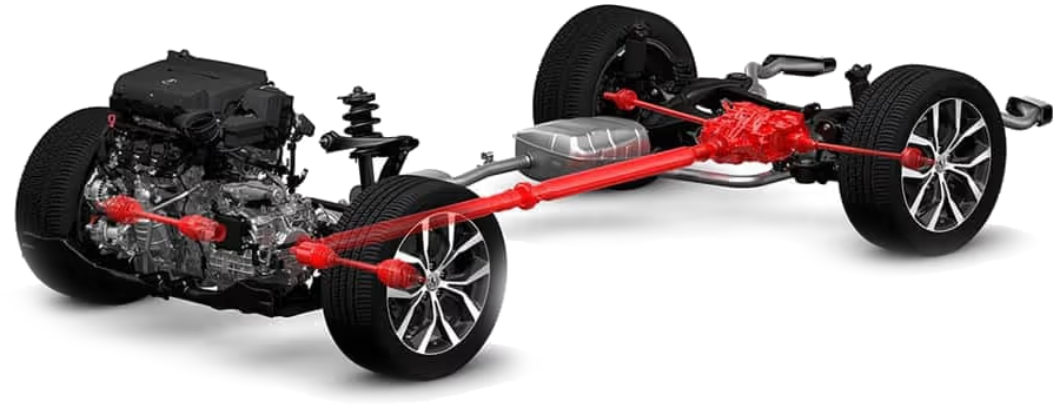The Story of Acura’s SH-AWD: From Concept to Corner-Carving Precision
Acura’s Super Handling All-Wheel Drive (SH-AWD) was engineered to do more than improve traction—it was designed to fundamentally change how a car behaves in motion. By actively distributing power not just front-to-rear but side-to-side, SH-AWD delivers sports-car agility with all-weather confidence. It’s one of Acura’s most innovative and defining technologies. Read the full story below.
Acura’s SH-AWD system originated from a simple but revolutionary idea: what if an AWD system didn’t just react to slip, but actively shaped the car’s handling? In the late 1990s and early 2000s, Acura engineers, in partnership with Honda’s R&D teams, explored ways to give larger, front-biased vehicles the nimble, rear-drive feel of a performance coupe. Instead of leaning on stability control and braking interventions, Acura wanted a system that used engine torque itself to rotate the vehicle and maximize grip.
Most AWD systems of the era—like Subaru’s symmetrical AWD or Audi’s Quattro—focused on distributing power for stability, not cornering performance. Acura’s philosophy was different. The solution was torque vectoring: precisely controlling how much power each rear wheel receives, in real time, based on steering input, throttle position, yaw rate, and more. After years of development, the first generation of Super Handling All-Wheel Drive debuted in the 2005 Acura RL, immediately redefining how a luxury sedan could handle.
SH-AWD’s breakthrough was its dual-clutch rear differential, which could overdrive the outside rear wheel by up to 5–10% faster than the front wheels. This “overdriving” effect created a subtle but powerful yaw moment, literally pushing the car around a corner. The result was crisp turn-in, neutral balance, and shockingly athletic handling for a vehicle with front-wheel-drive roots. Reviewers noted that the RL felt more rear-biased than many RWD sedans—an impressive achievement for a technology working behind the scenes.
As SH-AWD expanded to models like the MDX, TL, RDX, and TLX, each generation grew more capable. By 2007, the MDX’s version of SH-AWD could send 70% of available power to the rear axle and then route up to 100% of that power to either rear wheel. The system didn’t just counter understeer—it actively encouraged precision driving, giving even large SUVs remarkably agile dynamics. On wet or snowy roads, SH-AWD offered a feeling of planted stability without sacrificing playfulness.
The system reached an iconic moment with the 2009–2014 Acura TL SH-AWD, often celebrated as one of the best-handling front-biased sedans ever made. With its hydraulic steering, stiff chassis, and SH-AWD tuning, the TL delivered a level of confidence and rotation typically associated with European sport sedans—earning a cult following among enthusiasts. Acura’s dedication to tuning SH-AWD for each model meant that no two systems behaved exactly the same; the MDX prioritized stability and control, while the TL focused on sharpness and performance.
The second generation of SH-AWD brought mechanical refinements, lighter components, and quicker responsiveness. But the biggest leap arrived with the hybrid evolution of SH-AWD, introduced in the 2017 MDX Sport Hybrid and perfected in the second-generation NSX. Instead of mechanical torque vectoring at the rear, hybrid SH-AWD used electric motors to apply positive or negative torque instantly. The NSX’s system was particularly advanced: two motors at the front axle could independently accelerate or decelerate each front wheel, creating lightning-fast torque vectoring impossible with mechanical components. The result was extraordinary cornering precision and stability at the limits—technology derived directly from Acura’s racing programs.
In 2021, the TLX and 2022 MDX debuted the latest evolution of mechanical SH-AWD. Redesigned from the ground up, the new rear differential offered 30% quicker torque transfer, 40% more rear-axle torque capacity, and dramatically improved yaw response. Paired with Acura’s new ultra-rigid chassis platforms, the system delivered sharper turn-in, faster rotation, and greater driver confidence. The TLX Type S and MDX Type S became showcases for the technology, proving that SH-AWD wasn’t just about safety—it was a performance tool.
Today, SH-AWD remains one of Acura’s signature technologies, embodying the brand’s philosophy of precision crafted performance. Unlike traditional AWD systems that simply keep a vehicle stable, SH-AWD actively enhances the driving experience—making cars feel lighter, more responsive, and more intuitive. It’s one of the reasons Acura vehicles often handle better than competitors with far more aggressive branding or marketing hype.
For enthusiasts, SH-AWD is a hidden gem: a system that turns everyday driving into something more engaging, more confident, and more connected. Whether navigating mountain switchbacks or wet city streets, SH-AWD proves that the right engineering can make a vehicle feel like an extension of the driver. Nearly two decades after its debut, it remains one of the most sophisticated and rewarding all-wheel-drive systems ever created—a quiet revolution in the world of performance handling.

